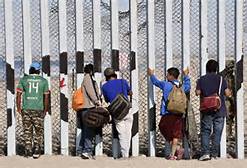
Rebecca Plevin, Palm Springs Desert Sun, November 15, 2018
Hundreds of people who arrived in Tijuana with the first wave of the migrant caravan planned to spend Wednesday night in a makeshift camp by the Pacific Ocean, steps from the tall border fence that separates Mexico and the United States. But those plans shifted in the evening, after local and state officials opened a temporary shelter — and about 300 local residents gathered by the encampment to demand the migrants leave the upscale Playas de Tijuana neighborhood and go to the facility.
{snip} Mostly women and children went to the shelters, while young men from the caravan said they were determined to stay together at the beach and await the estimated 2,000 more caravan members on their way to Tijuana.
Pushing, shoving, kicking and a couple of blows broke out between masses of residents and migrants, illuminated by the crescent moon and mobile light towers, set up by authorities on the beach on the U.S. side of the border. More than three dozen municipal and federal police watched, separating people and trying to prevent the situation from devolving into fistfights and chaos.
{snip}
By Thursday, the migrants had left the beach and joined hundreds of caravan members at a temporary shelter at the Benito Juarez sports complex. The complex has room for 3,000 people to sleep on thin mattresses on the floor of an indoor basketball court, in large, communal tents and in individual camping tents, according to a local official.
{snip}
Rueda Gómez said it will cost about $4 million to care for the migrants for two months, including providing food and medical care. He said the state government can only afford to fund this work for 10 days at the most, so he has asked the federal government for support.
{snip}
The conflict was foreshadowed earlier in the day at the beach. By the afternoon, two large groups of migrants — a total of about 750 people — had arrived in Tijuana. The city’s migrant shelters had limited space when the caravan arrived. A large portion of the migrants said they didn’t want to be separated, opting instead to sleep at the beach.
{snip}
Meanwhile, Playas de Tijuana residents marched through the neighborhood to call for security and demand the migrants go to the shelters.
By 8:30 p.m., hundreds of residents and migrants had congregated by the beach, with local residents demanding the immigrants leave the public space at the beach.
As the conflict intensified, Irineo Mujica, an immigrant activist who helps organize migrant caravans, said the migrants still at the beach – and the ones en route to Tijuana – wouldn’t go to the shelters. He referred to them as “jails” with strict curfews. He said he was concerned that non-governmental organizations wouldn’t be allowed into the shelters, making it harder for the migrants to remain organized as one collective.
“For this reason — because this is oppression — we prefer to be in the streets, in the cold, rather than in a jail,” Mujica said.
There are at least three separate migrant caravans making their way through Mexico. Nearly 900 people from the first caravan arrived in Tijuana this week and on Wednesday night, local and state officials estimated 2,000 more were on their way. Several hundred of those 2,000 arrived Thursday morning, according to local reports. A second caravan started arriving in Mexico City Tuesday and as of Wednesday, a third caravan was traveling through Veracruz, on the eastern side of Mexico.
{snip}
Gustavo Magallanes, who oversees migrant affairs for the state of Baja California, said the arrival of the caravans in Tijuana is not a humanitarian crisis. The challenge, he said, is that so many people are arriving in such a short period of time. On top of that, he said, there are limited resources available for the migrants, as state and local governments are nearing the end of their fiscal years.